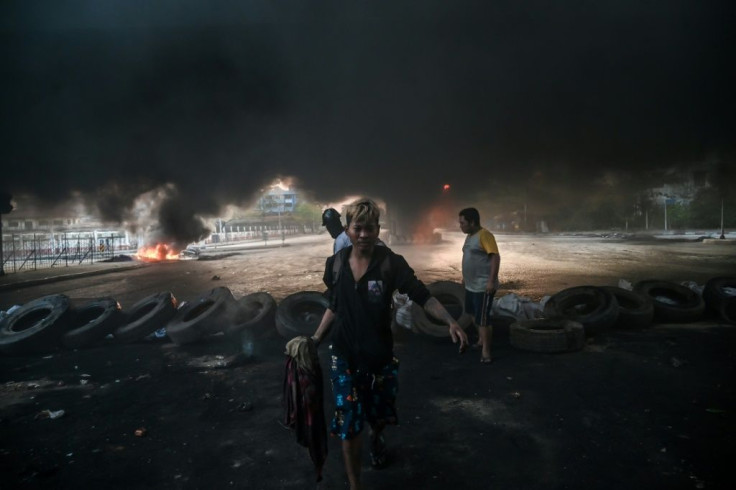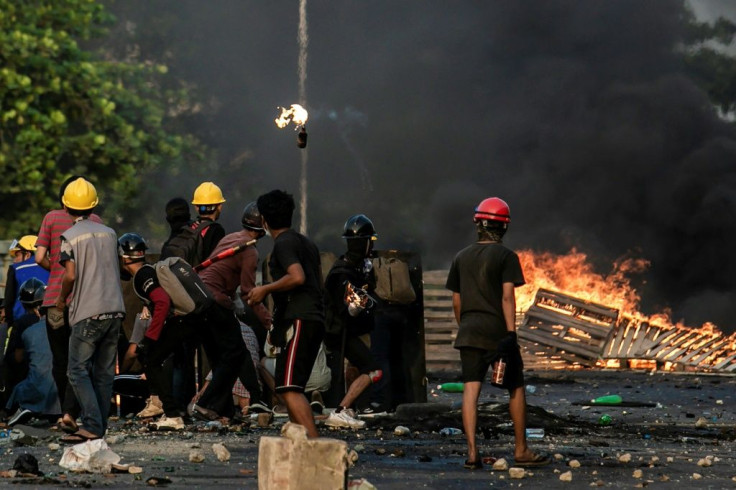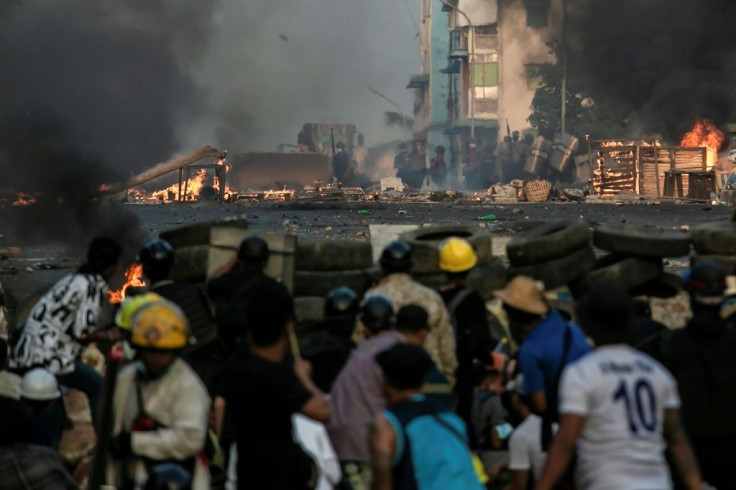Township A Battle Zone As Myanmar Junta Enforces Martial Law
Plumes of smoke rose Wednesday above a part of Myanmar's biggest city which has turned into a battle zone under martial law, with burning barricades and security forces firing at unarmed anti-coup protesters.
Traumatised residents have fled Hlaing Tharyar, an industrial neighbourhood in Yangon that has become a flashpoint in a nationwide uprising against the military's coup nearly seven weeks ago.
The junta has increasingly deployed heavy force to quell the demonstrations, with more than 200 protesters reported to have been killed across the country.

Sunday was the deadliest day so far, with a local monitoring group documenting more than 70 people killed -- the bulk of them in Hlaing Tharyar.
The junta on Sunday imposed martial law on the township and later on other protest hotspots -- effectively placing nearly two million people under the complete control of military commanders.
Residents -- many of them migrant workers -- have since fled back to their home states, piling their belongings and families onto flat-bed trucks and the backs of motorbikes.

Those who stayed reported warlike scenes.
"There were constant gunshots the entire night and we didn't get to sleep," one resident told AFP, adding people were worried about even walking on the streets for fear of getting targeted by security forces.
Another resident, a medical student, said there was a heavy military and police presence around the main parts of the township.

"They were checking cars, motorbikes and the mobile phones of people going around the streets," he told AFP.
"If they detected anything related to politics and the civil disobedience movement, they arrested people," he said, adding that authorities also threatened residents to make them remove barricades around the area.
Hardline anti-coup protesters had camped on a bridge leading into the township's main roads on Tuesday evening, wearing hard hats and gas masks, and carrying shields.

They had erected barricades made out of tyres, wood, sandbags and bamboo poles.
Some of those barricades were burned, leading to heavy black smoke rising above the mostly deserted streets.
Some protesters threw petrol bombs at the security forces, but otherwise appeared defenceless as they hid behind makeshift shields.

In a residential area of a neighbouring township, video footage verified by AFP showed non-stop volleys of gunfire lasting roughly 15 seconds.

In recent days, Hlaing Tharyar has become "an urban war zone", said Debbie Stothard, deputy secretary of the International Federation for Human Rights (FIDH).
"We heard a lot of people have been arrested in the last few days but it is really difficult to get information on what is happening on the ground," she told AFP.
Information on arrests and violence has been trickling out of the conflict areas on social media -- the flow slowed due to the junta's throttling of mobile data.
Many in Myanmar have not been able to use their mobile internet since the early hours of Monday.
The country is also placed under a nightly internet shutdown for eight hours.
More than 200 people have died in anti-coup unrest, according to the Assistance Association for Political Prisoners, a local monitoring group.
Pope Francis on Wednesday reiterated calls for an end to violence in Myanmar, referencing a nun in northern Kachin state who last week knelt before security forces to beg them not to open fire on anti-coup protesters.
"I, too, kneel on the streets of Myanmar and say, 'End the violence,'" the 84-year-old pontiff said during his weekly audience.
"I too extend my arms and say, 'Let dialogue prevail. Blood resolves nothing.'"
Protesters continued taking to the streets Wednesday, with local media broadcasting images of people marching through the northern Hpakant and central Sagaing regions.
In the country's second-largest city Mandalay, saffron-robed monks marched alongside demonstrators carrying the red flags of Suu Kyi's National League for Democracy (NLD) party.
The UN on Wednesday announced its Independent Investigative Mechanism for Myanmar was collecting evidence "regarding arbitrary arrests, torture, enforced disappearances and the use of force".
"The persons most responsible for the most serious international crimes are usually those in high leadership positions," said the head of the investigative unit, Nicholas Koumjian.
The junta has continuously justified the coup by alleging widespread electoral fraud in November's elections, which the NLD swept in a landslide.
Army chief Min Aung Hlaing has held legislative, executive and judicial powers over the country since the coup on February 1.
© Copyright AFP 2024. All rights reserved.





















